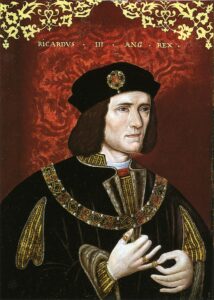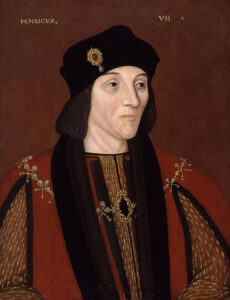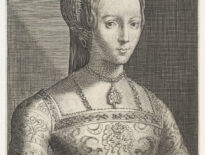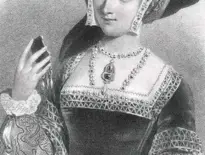In 2010, after a painstaking and detailed survey, the true site of the Battle of Bosworth was finally found. However, it has left more questions than it answered, not least how exactly did a rag tag army manage to beat a vastly superior royal force? The answers lie in a re-examination of the contemporary accounts of the battle in the context of the landscape of the newly found battlefield.
Why Richard III sacrificed his superior position on Ambion Hill may never be known, but he seems to have walked into a carefully prepared trap. The archaeological investigation has shown that the ground on which the battle was fought was damp and boggy with high ground behind, giving Henry Tudor a distinct advantage not only in height, but also because it limited the effectiveness of Richard’s superior firepower. Medieval cannon balls did not explode, instead they skipped across the landscape like a pebble across water, shattering everything in their path. If the ground was wet however, they would simply bury themselves in the ground at the first or second bounce. In an age where everything was recycled or reused, this was probably why so many cannon balls were found on the site during the 2010 excavations.
The Ballad of Bosworth Field tells us that the Stanley’s withdrew to a mountain where they looked across the plain and could not see the ground for men and horses. So, it seems likely that William Stanley was in the area around Crown Hill and Thomas further east near Stoke Golding, or behind his brother, It could be that it is this position to which Virgil refers when he says “…Thomas Stanley, who was now approchyd the place of fight, as in the mydde way betwixt the two battaylles, that he wold coom to with his forces, to sett the soldiers in array”, because it would have been close to half way between the two armies before they set out. From their position, they dominated the landscape. Once Richard saw them, he was forced to deploy his army parallel to the Roman road, as whichever way he turned, he could be attacked in the flank or rear. The archaeological survey has revealed a line of battlefield debris, with a broken sword hilt at one end and the boar badge at the other, almost parallel to the road, which suggests that, the battle, and therefore both armies were lined up was west to east. The length of this line of debris is around 914 metres (1000 yards), which also matches Vegetius’s recommendation for the frontage of an army. Molinet tells us that:

“King Richard prepared his "battles", where there was a vanguard and a rearguard; he had around 60,000 combatants and a great number of cannons. The leader of the vanguard was Lord John Howard…Another lord, Brackenbury, captain of the Tower of London, was also in command of the van, which had 11,000 or 12,000 men altogether.”
We therefore have Norfolk is in command of the first line, probably with his son Thomas, Earl of Surrey and Lord Brackenbury. Thomas had served a two year military apprenticeship in Burgundy under Charles the Bold from 1466 to 68 at the request of Edward IV, then fought beside him at Barnet, so like his father, was an experienced commander. It must have been an impressive sight as Virgil describes the vanguard as:
“stretching yt furth of a woonderfull lenght, so full replenyshyd both with foote men and horsemen that to the beholders afar of yt gave a terror for the multitude, and in the front wer placyd his archers, lyke a most strong trenche and bulwark”.
Like the Battle of Towton twenty-four years earlier, it appears that all the archers were brought to the front, including Richard’s yeoman archers. Only mentioned in passing, there was also a number of hand gunners. These were probably Burgundians under the command of Salaçar in the first line or on the flanks and may have been in blocks or dispersed throughout the archers.
Behind the vanguard was Richard and “a choice force of soldiers”. This was no doubt his bodyguard, household troops, and personal retainers. Behind them was the Earl of Northumberland with what the Crowland chronicler describes as a large company of reasonably good men.

A number of historians have suggested that Richard’s three battles were in a line, side by side, with Northumberland on the right. It has also been suggested that the reason that Northumberland does not get involved is because he is pinned in place by the Stanley’s. Neither is likely because firstly, to get to Henry, we are told that Richard has to move past both vanguards. We have already seen that the vanguard contained archers and foot. There is no mention of him passing Northumberland. Secondly we are told that Northumberland should have charged the French. This would have been impossible if he was on the opposite flank.
We must now turn our attention to the artillery. The Ballad of Bosworth hints at Richard’s deployment of his guns when it says:
“They had 7 score Serpentines without dout,
that locked & Chained vppon a row,
as many bombards that were stout;
like blasts of thunder they did blow”.
Why chain the guns together if they are in the centre of a line? The chains would certainly hamper any movement of the infantry. However, positioning guns on the flank, in enfilade, was a common European tactic as they could rake lines with cannon fire and cause maximum destruction to his ranks. They would also create an effective barrier, protecting that flank against attack. They would also potentially be in danger of being dragged off, so it would makes sense to chain them together. There is also some evidence to support this theory, as small groups of cannon balls were found close to the road, just where you would expect the guns to be positioned.
The find of the gilt boar on the edge of the marsh and Virgil’s statement confirms the location of the Henry’s right flank. We hear from Polydore Virgil that:
“There was a marsh betwixt both hosts, which Henry of purpose left on the right hand, that it might serve his men instead of a fortress, by the doing thereof also he left the sun upon his back”
And then that Henry:-
“made a sclender ward for the smaule number of his people ; before the same he placyd archers, of whom he made captane John erle of Oxfoord ; in the right wing of the vanward he placyd Gilbert Talbot to defend the same ; in the left verily he sat John Savage”.
It is interesting to note that the earliest versions of Virgil only describe Oxford’s line as a division and not the vanwarde or main division. As Henry had fewer guns, it makes sense that he would have placed them as far as possible from the enemy gun line and if they were on the left flank, would have helped to protect it, without hampering movement. Having established the approximate positions of the battle lines, by examining the pattern of finds of cannon balls we can estimate the positions of artillery. The natural target for the guns would be the centre of line, so with this in mind, cones of fire emanating from Richard’s and Henry’s left flanks can be traced. In both cases, this would place them close to the roads. And, as guns were heavy and difficult to move across country, it would only be natural to place them as close to the road as possible.
Key to how the battle unfolded is the location and subsequent actions of the French. There were between 1,000 and 4,000 of these professional troops (depending on the source) under the command of Philbert de Chandée. All were all trained in the Swiss way of war with pike and halberd and probably came from the defunct camp at Pont de l’Arche. With them was between 500 and 1,000 Scottish soldiers, all who had served in the French army and familiar with their fighting methods. Jean Molinet says that they were not part of the main army and that:
“The French also made their preparations marching against the English, being in the field a quarter league away…knowing by the king's shot the lie of the land and the order of his battle, resolved, in order to avoid the fire, to mass their troops against the flank rather than the front of the king's battle.”.
The second half of this statement also reinforces the idea that Richard had his guns on the flank, because if the French were on the opposite flank to the guns, they would have avoided their fire. Not so if the guns were to the front.
A stanza in ‘The Ballad of Bosworth Field’ says:
Then the blew bore the vanguard had;
He was both warry and wise of witt;
The right hand of them [the enemy] he took'
The sunn and wind of them to gett.
A separate attack on the flank, was a common tactic and recommended by Vegetius. So, if the Ballad’s ‘vanguard’ is the main body of the French, then it was these who had the sun behind them, then the east/west battle line makes perfect sense.
The Ballad of Bosworth does confuse the issue when it says:
“theyr armor glittered as any gleed;
in 4 strong battells they cold fforth bring;
they seemed noble men att need
as euer came to maintaine [a] King”
The most likely explanation for this is that the author is referring to Henry’s army and the four battles are Oxford’s, the French and the two Stanley’s. It was a common Swiss and French tactic to form up in four battles, in echelon (obliquely), and was successfully employed by the Swiss at the Battle of Morat nine years earlier.
The Battle
A number of historians have described the battle as a clash between the old style (Richard) and the new, continental style of warfare, also that Richard did not know how to respond to Henry’s tactics. Given that many of Richards’s men had been fighting on the continent and that Salaçar was newly arrived from Europe, this was almost certainly not the case.
Henry must have advanced on Richard first, as the Crowland chronicler says that “the earl of Richmond with his men proceeded directly against King Richard”. No doubt Richard’s artillery opened fire as soon as they were in range and Norfolk’s archers would have followed suit. With the likely amount of firepower arrayed against them, Henry’s men had no alternative but to advance or else be destroyed where they stood. Then, when Richard saw Henry’s army passing the marsh:
“… he commandyd his soldiers to geave charge uppon them. They making suddanely great showtes assaultyd the enemy first with arrowes, who wer nothing faynt unto the fyght but began also to shoote fearcely ; but whan they cam to hand strokes the matter than was delt with blades”.
Norfolk’s archers shoot as they charge to meet Henry’s men. Henry’s archers shoot back. Then, as they near, grasping their bucklers, many of the archers draw their swords ready for the hand to hand fighting to come. Medieval warfare was bloody and brutal. With a resounding crash the two sides meet: swords slash, bills and halberds chop and stab. The archers still with their bows, taking pot-shots where they can. The fully armoured knights with their retinues following behind, carve their way through the lightly armoured men with sword or pollaxe, looking for equals. Small groups of lightly armoured men pin down heavily armoured opponents looking for chinks in their armour so they can deal the coup de grâce. The noise must have been deafening as metal clashing with metal mingled with shouts and cries, and the roar of cannon and handgun. The whole scene shrouded in a fog of gunpowder smoke.
The two sides then disengage. Why is not clear. Perhaps it was, as modern research suggests, necessary for both sides to pause for breath as in all medieval battles. It may have been because Oxford’s division was being beaten and he was in fear of being enveloped as Virgil tells us :
“fearing lest hys men in fyghting might be envyronyd of the multitude, commandyd in every rang that no soldiers should go above tenfoote from the standerds;… with the bandes of men closse one to an other, gave freshe charge uppon thenemy, and in array tryangle vehemently renewyd the conflict”.
However, reforming them into triangle (wedge) formations sounds more like a pre-arranged plan (once again a tactic recommended by Vegetius). Oxford’s division then charged again. It was probably at this point that the French suddenly appeared on Norfolk’s right flank, with the sun behind them. Bristling with sixteen foot longspears and screened by hand gunners and crossbow men, they crashed into his line. The pikemen began to break Norfolk’s line apart. Further evidence of this can be found in a fragment of a letter written by a Frenchman soon after the battle. This long lost letter, which was quoted in an paper written by Alfred Spont in 1897 says that Richard had shouted “These French traitors are today the cause of our realm’s ruin”. The only way they could have been stopped was either with the artillery, which was on the opposite flank, or the archers and hand gunners; but these were engaged in hand to hand fighting to their front. A third option would have been to charge them with Richard’s cavalry, however, against the pikes, the chances of success were slim. The French were, in effect unstoppable and Richard had been out manoeuvred.
And where was Northumberland whilst the battle was raging? The Crowland chronicler wrote that:
“In the place where the earl of Northumberland was posted, with a large company of reasonably good men, no engagement could be discerned, and no battle blows given or received”.
Molinet also adds:
“The earl of Northumberland…ought to have charged the French, but did nothing except to flee, both he and his company, to abandon his King RIchard, for he had an undertaking with the earl of Richmond, as had some others who deserted him in his need”.
Was it his men in the third battle, that the chroniclers refer to as traitors? Northumberland was arrested and spent a short period in captivity after the battle, so it is unlikely that he had struck a deal with Henry. It is much more probable that seeing the French flank attack and the collapse of Norfolk’s line or when Richard was killed, he panicked. Deciding that they did not want to suffer the same fate, they simply ran. Molinet reports, that the vanguard which was led by the grand chamberlain of England, seeing Richard dead, turned in flight. It was Northumberland, not Norfolk, who was the chamberlain, and one version of the text actually says rearguard. So it is probable that there was an error in translating or transcribing the document at some point.
The situation must have been dire. Norfolk’s vanguard was collapsing and Northumberland’s men were fleeing. Virgil says that:
“king Richard might have sowght to save himself by flight ; for they who xver abowt him, seing the soldiers even from the first stroke to lyfc up ther weapons febly and fayntlye,and soome of them to tiepart the feild pryvyly”
By forming his men into wedges, Oxford had created gaps in his line. And it was through one of these gaps that Henry’s standard was spotted close to the marsh. Richard saw that it was Henry himself with a small body of mounted knights and infantry. If he could just reach Henry and kill him, then the battle would be over. So, Richard gathered his household cavalry and infantry around him and launched the last charge of the Plantagenet’s.
We do not know which route the charge took, however, the ground to the east of the marsh was boggy. Also, at least one stream had to be negotiated which would slow the impetus of any charge to a trot. And then there was the Stanley’s, they had still not committed and could block the cavalry before it reached Henry if they went east of the marsh. Speed was of the essence, so they must have taken the shortest route - through the gaps in Oxford’s line, west of the marsh. Virgil supports this when he says: “he strick his horse with the spurres, and runneth owt of thone syde withowt the vanwardes agaynst him”.
Gathering momentum, Richard and his supporters’ crash into Henry’s bodyguard. Richard kills William Brandon, Henry’s standard bearer and the standard falls to the ground only to be picked up by a Welshman, Rhys Fawr. Henry must have been close, because we are told by Virgil that next in Richard’s path is:
“…John Cheney a man of muche fortytude, far exceeding the common sort, who encountered with him as he cam, but the king with great force drove him to the ground, making way with weapon on every side”.
Richard’s personal standard bearer Sir Percival Thirwall, is also unhorsed and his legs cut from under him. As Henry’s men begin to buckle under the weight of the charge, up to three thousand fresh troops charge down from the hill into Richard’s cavalry and infantry who were still trying to fight their way through to Henry. William Stanley had finally decided to intervene and rescue Henry.
One by one, Richard’s followers are cut down in the melee that follows. Then Richard was killed. According to Virgil, he was “killyd fyghting manfully in the thickkest presse of his enemyes”. Molinet, on the other hand writes that “His horse leapt into a marsh from which it could not retrieve itself. One of the Welshmen then came after him, and struck him dead with a halberd”. In one version of events, it was later claimed that Rhys ap Thomas was the Welshman who killed him, although he was not a halberdier. Another version is that it was Ralph of Rudyard, which is near Leek in Staffordshire that dealt the fatal blow. Leek was part of the Stanley’s territories, so it was more likely he who killed him.
Richard’s courage during his last moments is unquestionable. Even his detractors are in agreement on this, as John Rous says, he “bore himself like a gallant knight and acted with distinction as his own champion until his last breath” . And the Crowland chronicler writes that “ King Richard fell in the field, struck by many mortal wounds, as a bold and most valiant prince”. Exactly where Richard died is not known although a proclamation by Henry soon after the battle, says it was at a place known as Sandeford. Where this was, has been lost in time, although it was most likely south of the marsh at a crossing point on one of the streams that fed the marsh.
Another fragment of the letter quoted in the Spont paper says that “he [Henry] wanted to be on foot in the midst of us, and in part we were the reason why the battle was won”. Without the rest of the letter, we do not know in what context this was said, however it is generally accepted that it implies that Henry retired behind a wall of French pikes when Richard charged. This is most unlikely, as Henry’s Standard Bearer would have been right beside him, and if Henry was behind a wall of pikes then so too was Brandon and Richard would have been unable to kill him. As the French were fighting on the flank, it probably means that Henry simply wanted to be part of the main flanking attack and it was because of this attack that the battle was won.
With Richard’s death, any remaining resistance quickly ended. There is archaeological evidence in the form of a tail of battlefield debris heading north east away from the battle site, and towards Ambion Hill. Some of the fugitives may have reached Daddlington Mill, well over a thousand yards away, as livery badge of an eagle with wings, probably once owned by a member of Norfolk’s or John Lord Zouche’s household was recently found close by. It may have been in this area that the remains of the Royal army made its last stand. Some, such as Lord Lovell and the Stafford brothers managed to escape completely and managed to reach sanctuary at St John’s in Colchester. Catesby was not so lucky, he was captured either at the battle or soon after, and executed three days later along with two yeomen named Bracher from the West Country.
We do not know who else died that day. Virgil puts the numbers of dead as a thousand from Richard’s army and scarcely one hundred from Henry’s. Molinet says only three hundred on either side whilst the Castilian Report says ten thousand in total. The truth probably lies somewhere in between. With the battle over, the victors looted Richard’s baggage train, which was probably on the site of the modern day Whitemoors car park. Richard’s royal regalia was collected by Henry’s officers and loaded onto his baggage train. William Stanley was offered the pick of the rest, and took a set of Richard’s tapestries which he proudly displayed at one of his residencies and Henry’s mother was sent his personal prayer book.
According to Virgil, with the battle over, Henry gave thanks to God for his victory and withdrew to the nearest hill. From here he thanked his commanders and nobles, knighted Gilbert Talbot, Rhys ap Thomas and Humphrey Stanley and gave orders that all the dead should be given an honourable burial. Thomas Stanley then crowned him Henry VI with Richard’s own crown, which according to tradition was found under a thorn bush close to where Richard was killed. We do not know how true this story is, although Henry did take the image of a crown and thorn bush as one of his badges soon after. As to the site of this momentous event, part of the high ground behind Henry’s battle line, originally known as Garbrody’s Hill and Garbrod Field in the fifteenth century was changed to Crown Hill and Crown Field before 1605, no doubt in reverence to the event.
Mike Ingram



Leave a Reply